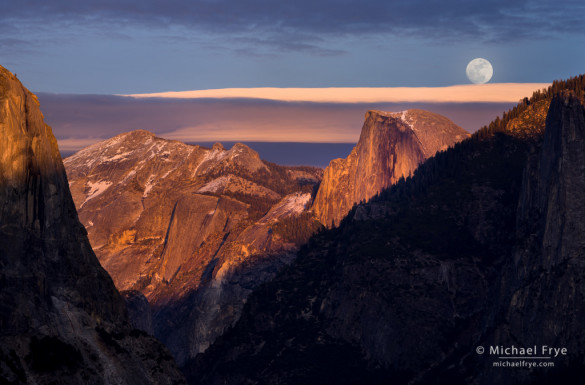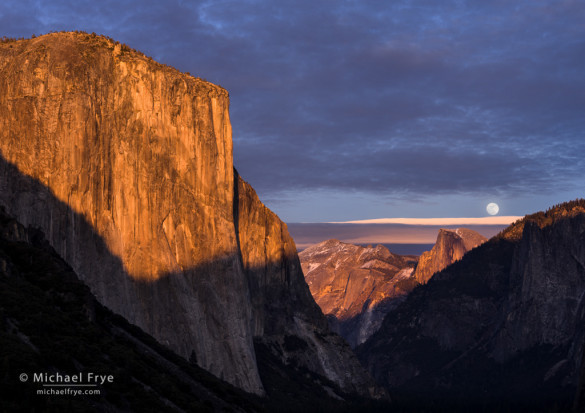During my workshop in Yosemite last week we photographed a spectacular moonrise on Monday evening from Tunnel View. A band of lenticular clouds hung in the sky in the distance, and just before the moon rose the sun broke through the clouds behind us and lit up El Capitan and Half Dome with vivid shades of orange.
In a recent interview I did for David Johnston and his Photography Roundtable podcast, we talked about using telephoto lenses for landscapes, and how using a longer lens is one way to simplify a composition. I use whatever lens seems appropriate for the situation – the lens that allows me to include all the essentials, but only the essentials. In the photograph above, that meant using my 70-200mm zoom at 183mm in order to fill the frame with the moon, Half Dome, that lenticular cloud, and the v-shaped notch below and to the left of Half Dome.
I made the photograph below 17 seconds later. There I zoomed out to 81mm to include El Capitan on the left. It’s nice to see El Cap, but showing it also meant I had to include a large swath of relatively featureless sky to the right of El Cap and above the moon. It’s a tradeoff, and most compositions, even successful ones, involve compromises. I probably have a slight preference for the photograph above because I think it has better balance and a little more impact, but it’s a close call, and I may change my mind tomorrow.
But either way, these are both telephoto views. A wide-angle lens for this scene, at that moment, would have turned El Cap, Half Dome, and the moon into tiny objects, and filled most of the frame with the not-so-interesting sky or the dark foreground, diluting the impact of the photograph.
In the podcast, David also asked me about how Ansel Adams influenced my work. I answered that Adams’ photographs have had a powerful impact on every contemporary landscape photographer, even though they might not realize it.
The photographers who came before Adams treated the landscape as something permanent. The best of them, like Carleton Watkins, made images that emphasized the sculptural qualities of the landforms they photographed. Adams was the first photographer to use light and weather to convey the mood of a landscape. His images aren’t about the shapes of rocks; they’re about the beauty and drama of a scene at a moment when the light and clouds were just so. And of course Adams used the rising moon to add drama and mood to two of his most famous photographs: Moonrise, Hernandez, and Moon and Half Dome.
So anytime somebody photographs the rising moon, or a clearing storm, or any moment when the light and weather create drama and mood in the landscape, they’re following in Adams’ footsteps. I think that influence is obvious in these photographs, and in most of my work, but also in the work of almost every contemporary landscape photographer. Adams changed the course of landscape photography, and directly or indirectly influenced everyone who followed, whether they’re aware of it or not.
You can listen to the entire interview on the Photography Roundtable website, or find it in iTunes. It’s free of course. You should also check out David’s interviews with Ian Plant, Joshua Cripps, Colby Brown, David duChemin, and Richard Bernabe – among many others.
— Michael Frye
Related Posts: Oceans of Fog: Part Two; Moon Above Half Dome
Did you like this article? Click here to subscribe to this blog and get every new post delivered right to your inbox!
Michael Frye is a professional photographer specializing in landscapes and nature. He is the author or principal photographer of The Photographer’s Guide to Yosemite, Yosemite Meditations, Yosemite Meditations for Women, Yosemite Meditations for Adventurers, and Digital Landscape Photography: In the Footsteps of Ansel Adams and the Great Masters. He has also written three eBooks: Light & Land: Landscapes in the Digital Darkroom, Exposure for Outdoor Photography, and Landscapes in Lightroom 5: The Essential Step-by-Step Guide. Michael has written numerous magazine articles on the art and technique of photography, and his images have been published in over thirty countries around the world. Michael has lived either in or near Yosemite National Park since 1983, currently residing just outside the park in Mariposa, California.











Hi Michael
I really like the second one.
How can one chose what is the best one as God made it perfect.
Thanks Denise! Like I said, it’s a close call for me.
Michael, I really struggle photographing a full moon. Last week when trying to capture what was probably the same moon as you did above, I really struggled to get the moon sharp but yet have some view of the surrounding landscape. I tried ISOs from 400 to 6400, I used long shutter speeds and short ones and the full range of F stops to no avail. Would you share what your camera settings were when you took the shots above?
thanks
Leslie, both images were ⅛ sec. at f/11, 50 ISO. But I strongly suspect that your problem wasn’t that you had the wrong camera settings, but rather that you were trying to photograph the moon in an impossibly high-contrast situation. You can’t photograph the full moon after dark and get detail in both the moon and the landscape. That’s like photographing the sun during the day and expecting to get detail in the sun (like sunspots) and in the landscape too. The sun is just too bright compared to the landscape to make that work. And the contrast between the moon and a moonlit landscape is just as great.
Both of my images here were made at sunset, when there was still plenty of light on the landscape from the sun. Photographing a rising or setting moon around sunrise or sunset is the only way to get detail in both moon and landscape. I discuss this in more detail in this post:
https://www.michaelfrye.com/2013/12/13/moonstruck/
Michael, thank you so much for your detailed and thoughtful answer
Wonderful compositions and processing, as usual!
Wow. It was a nice sight. I happened to be setup in the smaller parking lot across the street and now I know why so many tripods were trained on the moonrise. 😉
Thanks Kanwarjit, and I hope you got some moonrise photos from where you were.
Pleasure to look at your pictures.
Thanks PJ!
Michael,
I agree with you, my favorite is the top photo.
You are also correct that Adams’ work, consciously or unconsciously, has influenced most landscape photographers. He has inspired so many to see the beauty in nature that others often overlook. That is where mood comes into play.
Not that his B&W work could ever be improved but do you know if any attempt has been made to colorize some of his more famous images? Just wondering…
Finally, do you plan on reviewing the new Canon 5D S / 5D S R when it is released? As you know it is already on some of the commercial websites for pre-order.Is Sony planning any 50 MP cameras? All this reminds me of the “space race” of the 1950’s and ’60’s.
Thanks James, and I’m glad you also recognize Ansel’s influence. But colorize an Ansel Adams photograph? Sacrilege! He would roll over in his grave. 🙂 Although he did make color versions of a couple of his better-known black-and-white images, like Sand Dunes, Death Valley.
As for the 5DS, I’d like to try one, though it won’t be available until summer. There are rumors of new Sony and Nikon 46- or 50-MP cameras coming out soon too. I’ll probably write something about the 5DS at some point, and about those Sony and Nikon cameras if the rumors prove to be true.
Hi Michael and Claudia,
I love your moon shot, you are such a wonderful photographer. Can’t wait for the Redwoods class to being!
Sorry…”to begin.”
Thanks Connie! “Being” works too. 🙂